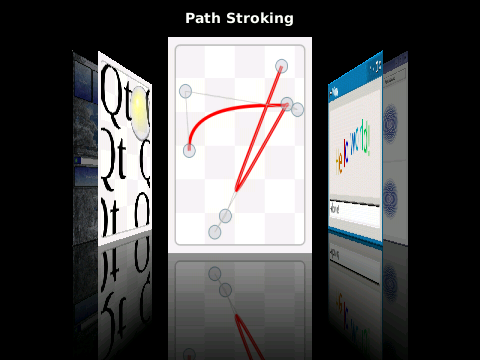FriendlyCore (based on ubuntu-core with Qt)
Contents
1 Introduction
Ubuntu Core with Qt-Embedded is a light Linux system without X-windows. It uses the Qt-Embedded's GUI and is popular in industrial and enterprise applications.
Besides the regular Ubuntu core's features our Ubuntu-Core has the following additional features:
- it supports our LCDs with both capacitive touch and resistive touch(S700, X710, S70)
- it supports WiFi
- it supports Ethernet
- it supports Bluetooth and has been installed with bluez utilities
- it supports audio playing
2 Download Image Files
Visit the product page of one of the following products and download the firmware nanopi2-ubuntucore-with-qt-embedded-sd4g.img.zip:
- NanoPi2, NanoPi M2, NanoPi T2: Download
- Uncompress the file and flash the image to an SD card with either dd under Linux or win32diskimager under Windows.
3 Applications under UbuntuCore
By default our UbuntuCore system brings up a Qt demo application whose GUI is as follows:

3.1 WiFi
Open the following file in the command line utility from a serial terminal:
vi /etc/wpa_supplicant/wpa_supplicant.conf
Append the following lines. Replace "ESSID" and "PASSWORD" with your actual ID and password:
ctrl_interface=DIR=/var/run/wpa_supplicant GROUP=netdev update_config=1 country=CN network={ ssid="ESSID" psk="PASSWORD" key_mgmt=WPA-PSK }
If your WiFi router doesn't have a password you can set "key_mgmt" to "NONE" and delete the whole line with "psk=".
Save, exit and run the following commands to restart WiFi connections:
ifdown wlan0 ifup wlan0
3.2 Ethernet Connection
If a board is connected to a network via Ethernet before it is powered on it will automatically obtain an IP with DHCP activated after it is powered up. You can change this behavior by changing the configurations in the following file:
vi /etc/network/interfaces
3.3 Bluetooth
If your board has built-in bluetooth module you can run the following command to search for a nearby bluetooth device:
hcitool scan
You can check the status by using command "hciconfig"
3.4 Playing Audio
You can play an audio file by running the following command:
aplay -t raw -c 2 -f S16_LE -r 44100 /root/test.pcm
3.5 Work with LCD
If you connect your board to an LCD with capacitive touch panel in general that LCD's calibration is not required. However if your LCD is one with resistive touch panel you will have to do calibration which is triggered by running "/usr/bin/setqt4env" on your first system booting.
If you want to re-calibrate your LCD with resistive touch panel you need to delete the calibration file by using the following command:
rm /etc/pointercal
After you reboot your system you will enter the calibration process.
4 Develop Qt Application
4.1 Install Qt-Embedded on Host PC
进入产品的下载页面,下载名为 target-ate-4.8.6-to-hostpc.tgz 的压缩包:
- NanoPi2, NanoPi M2, NanoPi T2: 下载
然后在电脑上,cd到根目录进行解压:
cd / tar xvzf ~/target-ate-4.8.6-to-hostpc.tgz
解压完成后,执行 qmake 验证一下安装:
/usr/local/Trolltech/QtEmbedded-4.8.6-arm/bin/qmake -v
应该会得到如下输出信息:
QMake version 2.01a
Using Qt version 4.8.6 in /usr/local/Trolltech/QtEmbedded-4.8.6-arm/lib
4.2 PC上安装交叉编译器(arm-linux-gcc 4.9.3)
首先下载并解压编译器:
git clone https://github.com/friendlyarm/prebuilts.git sudo mkdir -p /opt/FriendlyARM/toolchain sudo tar xf prebuilts/gcc-x64/arm-cortexa9-linux-gnueabihf-4.9.3.tar.xz -C /opt/FriendlyARM/toolchain/
然后将编译器的路径加入到PATH中,用vi编辑vi ~/.bashrc,在末尾加入以下内容:
export PATH=/opt/FriendlyARM/toolchain/4.9.3/bin:$PATH export GCC_COLORS=auto
执行一下~/.bashrc脚本让设置立即在当前shell窗口中生效,注意"."后面有个空格:
. ~/.bashrc这个编译器是64位的,不能在32位的Linux系统上运行,安装完成后,你可以快速的验证是否安装成功:
arm-linux-gcc -v Using built-in specs. COLLECT_GCC=arm-linux-gcc COLLECT_LTO_WRAPPER=/opt/FriendlyARM/toolchain/4.9.3/libexec/gcc/arm-cortexa9-linux-gnueabihf/4.9.3/lto-wrapper Target: arm-cortexa9-linux-gnueabihf Configured with: /work/toolchain/build/src/gcc-4.9.3/configure --build=x86_64-build_pc-linux-gnu --host=x86_64-build_pc-linux-gnu --target=arm-cortexa9-linux-gnueabihf --prefix=/opt/FriendlyARM/toolchain/4.9.3 --with-sysroot=/opt/FriendlyARM/toolchain/4.9.3/arm-cortexa9-linux-gnueabihf/sys-root --enable-languages=c,c++ --with-arch=armv7-a --with-tune=cortex-a9 --with-fpu=vfpv3 --with-float=hard ... Thread model: posix gcc version 4.9.3 (ctng-1.21.0-229g-FA)
4.3 编写并运行Qt版本的Hello world
在PC上建立个helloqt目录并新建一个main.cpp的源文件:
cd ~ mkdir helloqt vi main.cpp
main.cpp的代码如下:
#include <QApplication> #include <QPushButton> int main(int argc, char **argv) { QApplication app (argc, argv); QPushButton button ("Hello world !"); button.show(); return app.exec(); }
退出vi后,执行以下命令编译:
cd ~/helloqt /usr/local/Trolltech/QtEmbedded-4.8.6-arm/bin/qmake -project /usr/local/Trolltech/QtEmbedded-4.8.6-arm/bin/qmake make
编译成功后,会得到了 helloqt 的二进制文件,将它上传到开发板后,在串口终端用以下命令运行:
. setqt4env
helloqt -qws&4.4 开机自动运行Qt程序
以运行上一章节中的 helloqt4 程序为例,假设它放在 /root 目录,则你可以编辑 /etc/rc.local 文件,先删除以下这两行:
cd /usr/local/Trolltech/QtEmbedded-4.8.6-arm/demos/embedded/fluidlauncher ./fluidlauncher -qws&
注意需要保留 . /usr/bin/setqt4env 这一行内容,并在这一行的后面加上 /root/helloqt -qws & 即可。
4.5 开源的Qt程序
开机后显示的界面由Qt Demo换成了一个由友善之臂开发的,开源的Qt程序 (源代码位于/opt目录),该程序启动时显示系统状态信息,例如CPU和内存信息,工作温度和负载等信息,系统同时集成了 qmake,uic 等Qt工具的arm版本,这样你就可以在开发板上直接生成和编译Qt源代码。
5 常见问题
- 编译Qt程序时出现无法链接到 libts, libz等库
原因是你的 arm-linux-gcc 4.9.3 编译器没有集成这些库,到产品的下载页面重新下载一次编译器,重新安装后即可解决。
- UbuntuCore源码下载
我们是直接官方使用二进制的文件,UbuntuCore源码可到此链接下下载:http://packages.ubuntu.com/。